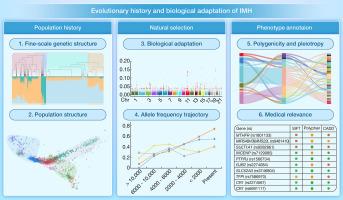Evolutionary history and biological adaptation of Han Chinese people on the Mongolian Plateau
Abstract
Complex demographic processes and natural selection pressures are critical to resolving patterns of the molecular genetic basis of adaptive traits or complex diseases. Recent ancient genome data allow us to trace how key traits evolved in different human populations over time, connecting ancient population history with disease susceptibility in western Eurasians. To fill this gap in eastern Eurasians and provide deep insights into the evolutionary history of the population-specific genetic basis of complex biological traits, we explored the evolutionary basis of adaptive traits in one integrative modern and ancient genomic database, including 225 out of 5583 genomes first reported here. We comprehensively characterized the demographic history and biological adaptation of Han Chinese individuals on the Mongolian Plateau based on the allele frequency spectrum and haplotype-resolved fragments. We found strong genetic homogeneity among geographically different Han populations from Inner Mongolia (IMH). We reconstructed their admixture models and demographic events, revealing that IMH had a close genetic relationship with ancient millet farmers and obtained additional gene flow from Altaic-speaking populations. The enrichment of selected candidate genes suggested that essential metabolism-related genes promoted the rapid adaptation of eastern Eurasians to ancient environmental shifts and dietary changes during agricultural innovations. Evolutionary trajectory reconstruction of metabolism-related genes of methylenetetrahydrofolate reductase (MTHFR) and fatty acid desaturase 1 (FADS1) suggested that ancient dietary shifts during the Neolithic transition period promoted the differentiated metabolic rate of folate and fatty acid. We revealed the polygenicity of biological adaptation traits and the pleiotropy of adaptive genes, indicating that complex recent polygenic adaptations, genetic interactions, and genotype–phenotype correlations have contributed to the genetic architecture of complex traits in eastern Eurasians.


 求助内容:
求助内容: 应助结果提醒方式:
应助结果提醒方式:


